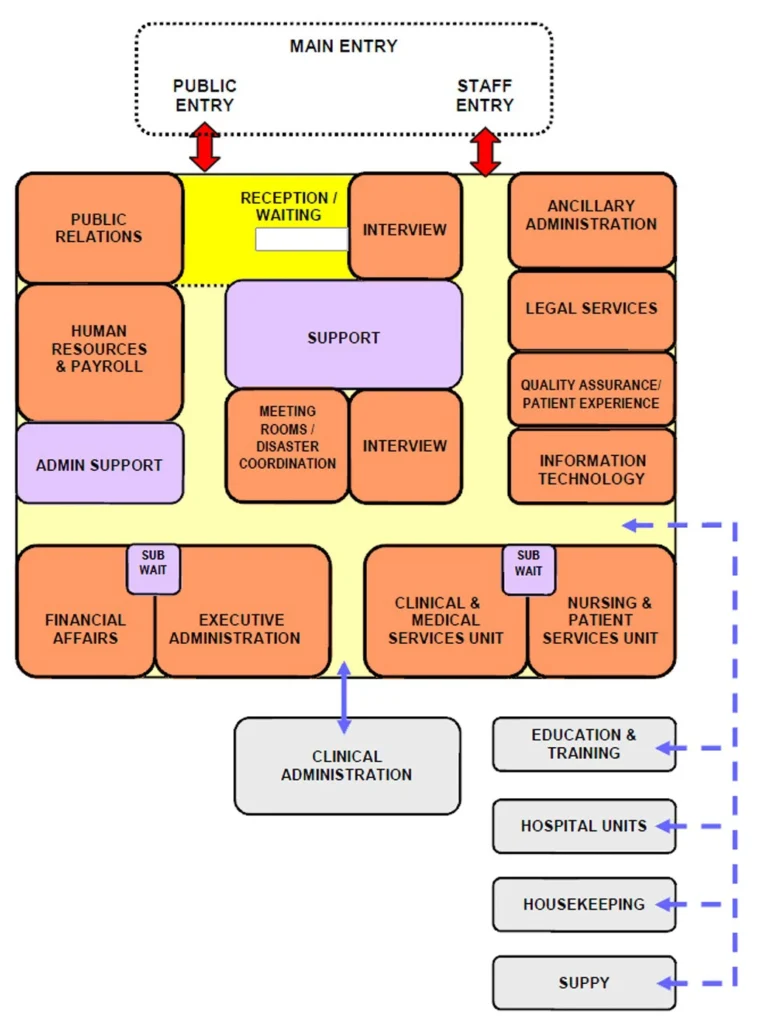The administrative unit in a healthcare facility serves as the backbone of hospital operations, ensuring smooth coordination between medical staff, patients, and management. It handles essential functions such as patient registration, medical record management, billing, appointment scheduling, and staff coordination. A well-structured administrative unit enhances operational efficiency, minimizes errors, and improves service delivery.
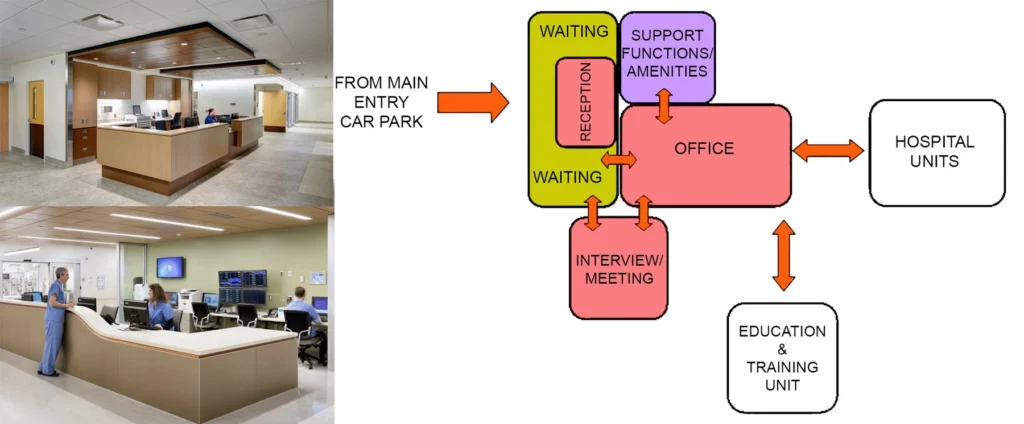
1) Definition of an Administration Unit
An administration unit in a healthcare facility is the central hub for non-clinical operations, ensuring the smooth functioning of hospital or clinic services. It manages essential administrative tasks that support medical professionals, patients, and overall hospital management. This unit is crucial for maintaining efficiency, organization, and compliance with healthcare regulations.
If you want to know about the Types of slabs or Permeable concrete or Islamic architecture, please click the link.
2) Key Functions of the Administration Unit
The Administration Unit provides for the direction and management of the facility. This will involve administrative tasks, interviews and meetings by a range of executive, medical, nursing and support personnel.
The level and range of facilities provided for general office and executive administration functions will vary greatly depending on the size of the proposed facility, the range of services prescribed in the Operational Policy Statement, and the management arrangements that will apply.
Provisions for the following administrative services shall be considered:
- Accounting and Finance
- CEO, General Manager and other administrative support staff
- Facility Management
- Human Resources and Payroll
- Education and Development staff
- Medical and clinical executive and support staff
- Nursing executive and support staff
3) Planning of administration unit
Proper planning of the administration unit in a healthcare facility is essential for efficiency, workflow optimization, and patient satisfaction.
i) Operating Models
The Administration Unit will generally operate during business hours. Meetings and functions being held after-hours will require access to be provided for both staff and visitors.
Depending on the size of the facility, Administration Unit may be provided as a single unit for small facilities, or as separate functional units grouped according to services (medical, nursing, education etc) in multiple locations for larger facilities.
ii) Planning Models
Provision of daylight shall be maximised throughout the Unit especially for those who spend most of their working hours in a single confined space. Offices should be provided with external windows, where possible.
iii) Functional Areas
Facilities shall be provided to accommodate the following administrative functions according to the Operational Policy:
- General and/or individual office accommodation for appropriate clerical, administrative, medical and nursing personnel, if required; where possible, open-plan workstations shall be considered
- Storage of office equipment, stationery and supplies
- Meetings and conferences as required
- Staff and support areas including Staff Rooms and toilets
The Administrative and Clerical staff shall have access to toilet and dining facilities, which may be shared with other hospital staff.
Functional Zones – For larger facilities where a single unit is not sufficient to accommodate all functions, the following services may be provided as smaller individual units:
- Clinical and Medical Services Unit
- Executive Suite (may include Meeting/ Boardroom, Pantry, Waiting and Reception area)
- Facilities Management Unit
- Finance Unit
- HR and Payroll Unit (Occupational Health and Safety staff may be included; Medical and Nursing personnel may be separate units)
- Education and Development Unit
- Nursing and Patient Services Unit
iv) Functional Relationships
External – Administration facilities should be provided, where possible, in reasonable proximity to the main entrance of the facility but not necessarily on the ground floor.
Internal – If several discreet units are provided, it is recommended to locate the executive suite and the finance unit adjacent to each other.
4) Design administrative unit
A well-designed administrative unit ensures smooth hospital operations by integrating space management, technology, security, and staff productivity.
i) Environmental Considerations
Natural light – Maximise provision of natural light to areas where staff workstations / offices are located.
Privacy – Privacy must be considered where confidential conversations are likely to take place. Acoustic privacy will be required in offices, meeting and interview rooms.
Acoustics – Acoustic performance shall be high within the Unit, particularly conference and meeting rooms. Reverberation times and sounds levels shall be designed to meet the function of each space.
ii) Safety and Security
Administration Unit requires the following security considerations:
- Doors to all offices shall be lockable
- Rooms located on the perimeter of the Unit shall be locked at any time when they are not occupied by staff
- Rooms used for storing equipment and files must be lockable
- Provision of after-hours access and security for staff.
iii) Building Service Requirements
Provide IT/ Communication facilities including telephone lines, data connections, teleconferencing and videoconferencing as required within the Unit.
iv) Components of the Unit
General – The Administration Unit will contain a combination of Standard Components and Non Standard Components. Provide Standard Components to comply with details in the Standard Components described in these Guidelines. Refer also to Standard Components Room Data Sheets and Room Layout Sheets.
Non Standard Components (Office – Executive)
Description and Function
The Executive Offices will be provided for facility or service directors and will be a larger room to allow for small meetings within the office.
Location and Relationships
The Executive offices may be provided as a zone within the Administration Unit with a Reception and secretarial offices in close proximity.
Considerations
Refer to Standard Components Office – CEO for the basic requirements. In addition, the Executive offices may include the following:
- Executive style furniture and fittings including joinery
- Entertainment facilities including television, DVD
- Beverage bay including refrigerator within the room or immediately adjacent
- Closet or wardrobe for items of clothing, briefcase, small items of luggage
- Comfortable seating that may include sofa lounges.
5) Schedule of Accommodation
i) Administration Unit Generic Schedule of Accommodation
Schedule of Accommodation for an Administration Unit
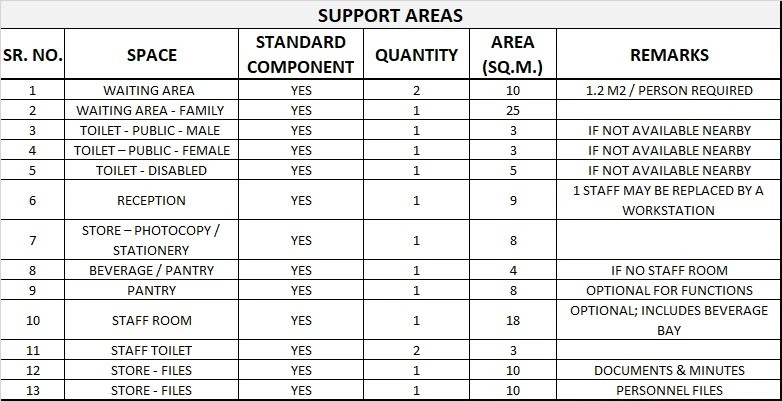
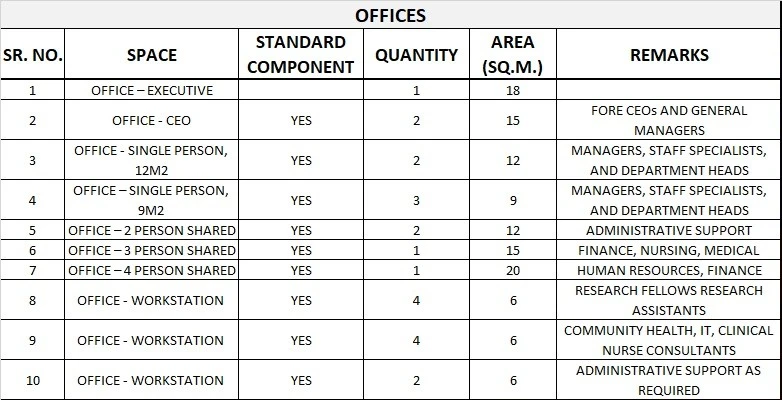
Notes for office and workstation :
Quantity to be determined by staffing establishment
Executives and Managers may be responsible for more than one area, but should have only one office assigned within the campus
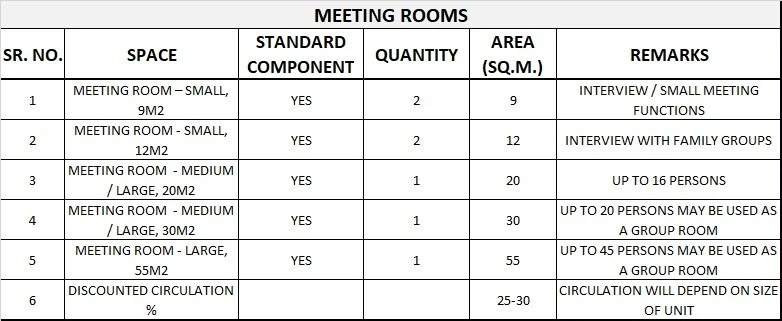
Please note the following
- Areas noted in Schedules of Accommodation take precedence over all other areas noted in the FPU.
- Rooms indicated in the schedule reflect the typical arrangement according to the Role Delineation.
- Exact requirements for room quantities and sizes will reflect Key Planning Units identified in the service plan and the policies of the Unit.
- Room sizes indicated should be viewed as a minimum requirement; variations are acceptable to reflect the needs of individual Unit.
- Office areas are to be provided according to the Unit role delineation and staffing establishment.
- Staff and support rooms may be shared between Functional Planning Units dependant on location and accessibility to each unit and may provide scope to reduce duplication of facilities.
6) Functional Relationship Diagram
Administration Unit Functional Relationship Diagram
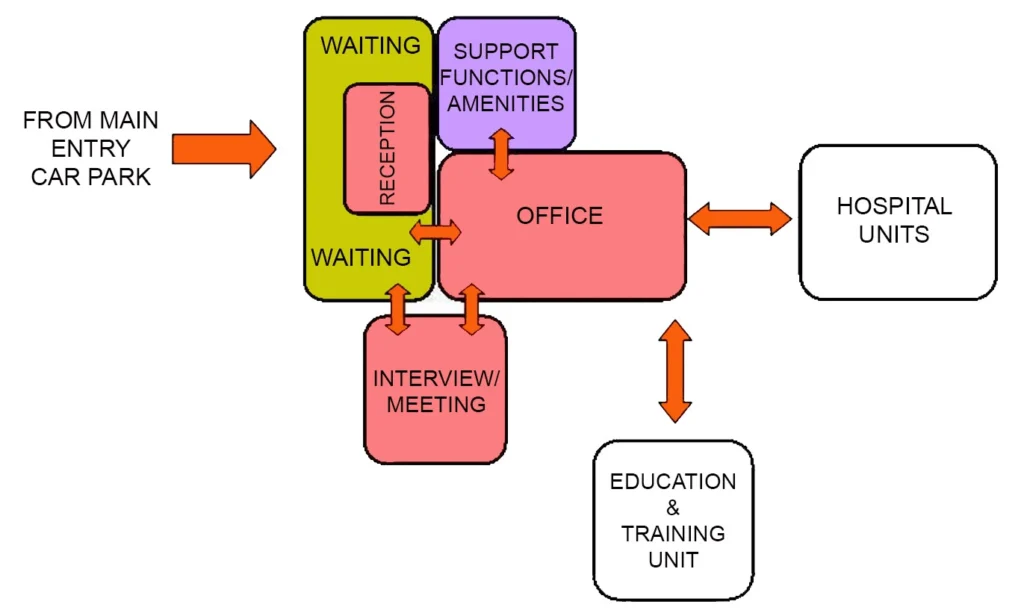
Administration Unit Functional Relationship Diagram (For International)
